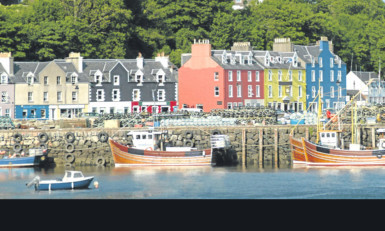
Scotland’s scenery makes for a perfect holiday destination.
Marking the transition from Lowland to Highland Scotland, Argyll is an area of great natural beauty and enormous variety.
Here you find all the ingredients of a classic Scottish holiday heather-clad mountains, peaceful wooded glens, attractive fishing ports, romantic castles, and beautiful lochs.
It’s a vast tract of land, a region of peninsulas and scattered islands which stretches from Appin and Oban in the north to the Mull of Kintyre in the south, and includes the islands of Mull, Jura and Gigha. Within its boundaries are some of the very best Scotland has to offer.
Further north you find Caithness and Sutherland, whose north coast is one of the largest areas of unspoilt scenery in Europe. The borders of Caithness are the Pentland Firth to the north and the Moray Firth to the east. The coast is low-lying on the east, and majestic to the north, with high cliffs and offshore stacks at places such as Duncansby Head.
Wick and Thurso are the main towns, making their living on a mix of fishing and tourism. Near Thurso you find the wonderful Castle and Gardens of Mey.The Queen Mother first saw what was then Barrogill Castle in 1952, while mourning the death of her husband, King George VI. She fell in love with its isolated charm and, on learning it was going to be abandoned, she decided to buy and save it.
The Queen Mother renovated and restored the castle and also took pride in creating the stunning gardens that you see today. For almost half a century she spent many happy holidays there with friends and family.
Inland in Sutherland is the desolate flat peat bog of the Flow Country, one of the last true wilderness areas in Europe and a haven for wildlife.
Argyll boasts numerous prehistoric sites. Much of the region was once part of the ancient Kingdom of Dalriada, established by the Irish Celts who settled here in the 5th Century. Their capital was at Dunadd, near Lochgilphead, from where they gained ascendancy over the native Picts.
Argyll was subsequently ruled by Norse invaders, then by Somerled, a warlord whose successors, the MacDonalds, Lords of the Isles, were in turn usurped by the Campbells. They became the Dukes of Argyll and are among the largest landowners in the region. Reminders of all these past times can still be found and explored.
Despite being close to Glasgow, Scotland’s largest city, Argyll is sparsely populated. Oban, its largest town, has just 8,000 inhabitants, and it’s this rural aspect that makes Argyll such a great place to escape to.
Additional highlights:
Inveraray Castle
Inveraray is one of the prettiest towns on Loch Fyne, and its castle oozes charm, with its conical roofs and immaculately laid-out grounds. This is home to the Duke of Argyll, whose family have lived in Inveraray since the early 15th Century.
The Armoury Hall contains 1,300 pieces including Brown Bess muskets, Lochaber axes and swords from the Battle of Culloden. The State Dining Room and Drawing Room contain magnificent French tapestries, Scottish, English and French furniture and a wealth of works of art.
Benmore Botanic Gardens
In a magnificent mountain setting on the Cowal Peninsula lies Benmore, a garden steeped in history and surrounded by some of Scotland’s most dramatic scenery. The garden’s 120 acres have more than 300 species of rhododendron, and a spectacular avenue of giant redwoods. Glorious throughout the seasons, though perhaps the Spring is the very best time to visit to enjoy the vibrant blooms of rhododendrons and azaleas.
Waymarked walks lead to a beautiful pond, the historic Formal Garden and a viewpoint. It’s a full afternoon’s visit, and before you head home, take in the Courtyard Gallery, which hosts a diverse programme of exhibitions and events, and also allows you to stop for a cuppa and some home baking in the Benmore Caf. If you’re a keen gardener don’t miss the selection of books, gifts and plants at the Benmore Shop.
For more, go to visitscotland.com or northhighlandsscotland.com.

Enjoy the convenience of having The Sunday Post delivered as a digital ePaper straight to your smartphone, tablet or computer.
Subscribe for only £5.49 a month and enjoy all the benefits of the printed paper as a digital replica.
Subscribe